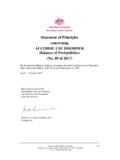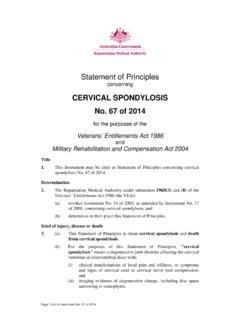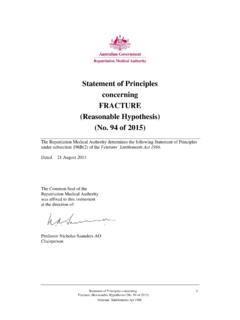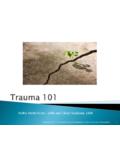Transcription of Statement of Principles concerning posttraumatic stress ...
1 Page 1 of 7 of Instrument No. 82 of 2014 Statement of Principles concerning posttraumatic stress DISORDER No. 82 of 2014 for the purposes of the Veterans Entitlements Act 1986 and Military Rehabilitation and Compensation Act 2004 Title 1. This Instrument may be cited as Statement of Principles concerning posttraumatic stress disorder No. 82 of 2014. Determination 2. The Repatriation Medical Authority under subsection 196B(2) and (8) of the Veterans Entitlements Act 1986 (the VEA): (a) revokes Instrument No. 5 of 2008, as amended by Instrument No. 19 of 2014, concerning posttraumatic stress disorder; and (b) determines in their place this Statement of Principles . Kind of injury, disease or death 3. (a) This Statement of Principles is about posttraumatic stress disorder and death from posttraumatic stress disorder.
2 (b) For the purposes of this Statement of Principles , " posttraumatic stress disorder" means a psychiatric disorder which meets the following criteria (derived from DSM-5): A. Exposure to actual or threatened death, serious injury, or sexual violence in one (or more) of the following ways: (i) directly experiencing the traumatic event(s); (ii) witnessing, in person, the event(s) as it occurred to others; Page 2 of 7 of Instrument No. 82 of 2014 (iii) learning that the traumatic event(s) occurred to a close family member or close friend. In cases of actual or threatened death of a family member or friend, the event(s) must have been violent or accidental; or (iv) experiencing repeated or extreme exposure to aversive details of the traumatic event(s) (for example, first responders collecting human remains; police officers repeatedly exposed to details of child abuse).
3 This criterion does not apply to exposure through electronic media, television, movies, or pictures, unless this exposure is work related; and B. Presence of one (or more) of the following intrusion symptoms associated with the traumatic event(s), beginning after the traumatic event(s) occurred: (i) recurrent, involuntary, and intrusive distressing memories of the traumatic event(s). In children older than six years, repetitive play may occur in which themes or aspects of the traumatic event(s) are expressed; (ii) recurrent distressing dreams in which the content and/or affect of the dream are related to the traumatic event(s). In children, there may be frightening dreams without recognisable content; (iii) dissociative reactions (for example, flashbacks) in which the individual feels or acts as if the traumatic event(s) were recurring.
4 (Such reactions may occur on a continuum, with the most extreme expression being a complete loss of awareness of present surroundings.) In children, trauma-specific reenactment may occur in play; (iv) intense or prolonged psychological distress at exposure to internal or external cues that symbolise or resemble an aspect of the traumatic event(s); or (v) marked physiological reactions to internal or external cues that symbolise or resemble an aspect of the traumatic event(s); and C. Persistent avoidance of stimuli associated with the traumatic event(s), beginning after the traumatic event(s) occurred, as evidenced by one or both of the following: (i) avoidance of or efforts to avoid distressing memories, thoughts, or feelings about or closely associated with the traumatic event(s); or (ii) avoidance of or efforts to avoid external reminders (people, places, conversations, activities, objects, situations) that arouse distressing memories, thoughts, or feelings about or closely associated with the traumatic event(s); and Page 3 of 7 of Instrument No.
5 82 of 2014 D. Negative alterations in cognitions and mood associated with the traumatic event(s), beginning or worsening after the traumatic event(s) occurred, as evidenced by two (or more) of the following: (i) inability to remember an important aspect of the traumatic event(s) (typically due to dissociative amnesia and not to other factors such as head injury, alcohol, or drugs); (ii) persistent and exaggerated negative beliefs or expectations about oneself, others, or the world (for example, I am bad , None can be trusted , The world is completely dangerous , My whole nervous system is permanently ruined ); (iii) persistent, distorted cognitions about the cause or consequences of the traumatic event(s) that lead the individual to blame himself/herself or others; (iv) persistent negative emotional state (for example, fear, horror, anger, guilt, or shame); (v) markedly diminished interest or participation in significant activities; (vi) feelings of detachment or estrangement from others; or (vii) persistent inability to experience positive emotions (for example, inability to experience happiness, satisfaction, or loving feelings); and E.
6 Marked alterations in arousal and reactivity associated with the traumatic event(s), beginning or worsening after the traumatic event(s) occurred, as evidenced by two (or more) of the following: (i) irritable behaviour and angry outbursts (with little or no provocation) typically expressed as verbal or physical aggression toward people or objects; (ii) reckless or self-destructive behavior; (iii) hypervigilance; (iv) exaggerated startle response; (v) problems with concentration; or (vi) sleep disturbance (for example, difficulty falling or staying asleep or restless sleep); and F. Duration of the disturbance (Criteria B, C, D, and E) is more than 1 month; and G. The disturbance causes clinically significant distress or impairment in social, occupational, or other important areas of functioning; and H.
7 The disturbance is not attributable to the physiological effects of a substance (for example, medication, alcohol) or another medical condition. (c) posttraumatic stress disorder attracts ICD-10-AM code Page 4 of 7 of Instrument No. 82 of 2014 (d) In the application of this Statement of Principles , the definition of " posttraumatic stress disorder" is that given at paragraph 3(b) above. Basis for determining the factors 4. The Repatriation Medical Authority is of the view that there is sound medical-scientific evidence that indicates that posttraumatic stress disorder and death from posttraumatic stress disorder can be related to relevant service rendered by veterans, members of Peacekeeping Forces, or members of the Forces under the VEA, or members under the Military Rehabilitation and Compensation Act 2004 (the MRCA).
8 Factors that must be related to service 5. Subject to clause 7, at least one of the factors set out in clause 6 must be related to the relevant service rendered by the person. Factors 6. The factor that must as a minimum exist before it can be said that a reasonable hypothesis has been raised connecting posttraumatic stress disorder or death from posttraumatic stress disorder with the circumstances of a person s relevant service is: (a) experiencing a category 1A stressor before the clinical onset of posttraumatic stress disorder; or (b) experiencing a category 1B stressor before the clinical onset of posttraumatic stress disorder; or (c) living or working in a hostile or life-threatening environment for a period of at least four weeks before the clinical onset of posttraumatic stress disorder.
9 Or (d) having a significant other who experiences a category 1A stressor within the one year before the clinical onset of posttraumatic stress disorder; or (e) experiencing the traumatic death of a significant other within the two years before the clinical onset of posttraumatic stress disorder; or (f) being exposed to repeated or extreme aversive details of severe traumatic events before the clinical onset of posttraumatic stress disorder; or (g) being the victim of severe childhood abuse before the clinical onset of posttraumatic stress disorder; or (h) experiencing a category 1A stressor before the clinical worsening of posttraumatic stress disorder; or (i) experiencing a category 1B stressor before the clinical worsening of posttraumatic stress disorder; or Page 5 of 7 of Instrument No.
10 82 of 2014 (j) living or working in a hostile or life-threatening environment for a period of at least four weeks before the clinical worsening of posttraumatic stress disorder; or (k) having a significant other who experiences a category 1A stressor within the one year before the clinical worsening of posttraumatic stress disorder; or (l) experiencing the traumatic death of a significant other within the two years before the clinical worsening of posttraumatic stress disorder; or (m) being exposed to repeated or extreme aversive details of severe traumatic events before the clinical worsening of posttraumatic stress disorder; or (n) being the victim of severe childhood abuse before the clinical worsening of posttraumatic stress disorder; or (o) inability to obtain appropriate clinical management for posttraumatic stress disorder.











